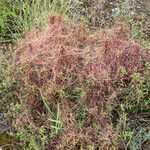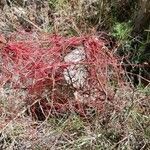Stems very slender, often reddish or purplish. Flowers ±3 mm long, in dense many-flowered clusters, often reddish. Calyx usually ± as long as corolla tube; lobes triangular, acute. Corolla: lobes triangular, acute, spreading, shorter than tube. Stamens shorter than corolla lobes; filaments longer than anthers. Scales ± spathulate; shorter than corolla tube, fringed mainly in upper part, free at apex. Ovary globose; stigmas filiform, slightly longer than styles, together almost twice as long as ovary. Capsule globose, circumscissile near base. Seeds usually 4, ovoid, ±1 mm long, rather rugose, angular, compressed, oblong, transverse, hilum short.
Parasitic, twining herb. Stems slender, reddish or purplish. Inflorescence dense, many-flowered clusters. Flowers 3 mm long, reddish. Calyx as long as corolla tube; lobes triangular. Corolla: lobes triangular, spreading, shorter than tube. Stamens shorter than corolla lobes; filaments longer than anthers. Scales spathulate; shorter than corolla tube, apex free, fringed. Ovary globose; stigmas filiform, longer than styles and ovary. Flowering time Jan.-May. Fruit a globose capsule, circumscissile near base. Seeds ovoid, 1 mm long, rugose.
Fls 5-merous, subsessile in dense, globose, head-like clusters; cal-lobes triangular-ovate, acute, generally a little shorter than the short-cylindric cor; cor-lobes triangular, 1–1.5 mm, shorter than the tube, acute, spreading; stigma slender, appearing as a continuation of its style, the two together longer than the ovary; fr globose, 1.5 mm, cupped by the withered cor, circumscissile near the base; seeds 4, scarcely 1 mm; 2n=14. Native of Europe, intr. throughout much of the U.S., parasitic chiefly on legumes.
Twining parasite. Styles 2, free to base; stigmas filiform, as long as or longer than style. Flowers herbaceous, ± 3 mm long, sessile, in dense, compact, globose clusters. Flowers reddish.












